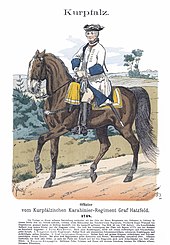Rittmaster

Rittmaster (German: Rittmeister, literally: riding master, cavalry master)[1] is or was a military rank of a commissioned cavalry officer in the armies of Germany, Austria-Hungary, Norway, Sweden, Denmark, and some other countries. A Rittmeister is typically in charge of a squadron (a company-sized unit called a "troop" in the United States, as opposed to the U.S. cavalry squadron of larger battalion size), and is the equivalent of a Hauptmann rank (or captain in most army branches).[2][3]
The Dutch rank Ritmeester, is the rank of squadron leading officers in the cavalry units of the Royal Netherlands Army.[4]
The Norwegian rank, rittmester/rittmeister, is the rank of officers in the armoured and mechanized infantry units of the Norwegian Army. The spelling ritmester was used in Norwegian until 1907.
- Swedish: ryttmästare
- Danish: ritmester
- Norwegian: rittmester (bokmål; the spelling ritmester was used until 1907) or rittmeister (nynorsk)
- German: Rittmeister (until 1951)
- Estonian: rittmeister
The armies of Poland, Finland, Lithuania, and Russia adopted a localised term for the similar rank.
- Polish: rotmistrz,
- Finnish: ratsumestari,
- Lithuanian: rotmistras,
- Russian: ротмистр (rotmistr).
In the Polish army (from the 15th century to the mid-20th century) a rotmistrz commanded a formation called a rota. However, a rotmistrz of hussars was a commander of between 100 and 180 hussars, with a lieutenant of hussars as his second-in-command. The Lithuanian term was rotmistras.[citation needed] In earlier times, the rotmistrz served as the commander of an infantry or cavalry company, though sometimes he would temporarily be assigned field rank tasks e.g. commanding an entire regiment or even a larger formation. In the cavalry, the rank continued until 1945 as a company level title. Applied to the commander of a troop, it was equivalent of a modern-day captain.
The rank was also adopted by Russian New Regiments as rotmistr (ротмистр) and later formalized in Table of Ranks as the cavalry post; until 1798, and between 1883 and 1918, a lower-ranking shtabs-rotmistr (штабс-ротмистр) also existed, representing the ranks of Senior Captain and Junior Captain in the Russian Imperial Guards Cavalry, Army Cavalry, Gendarmerie and Border Guards by 1914.
In British and Commonwealth military forces, a Riding Master is not a rank. In the Household Cavalry Regiment a suitable Warrant Officer with the rank of Riding Instructors is appointed Riding Master. The duration of this appointment is determined by the commanding Lieutenant-Colonel and, once appointed, the Riding Master is the person in the lead of training of recruits and horses of the Household Cavalry Regiment.[5]
Insignia[edit]
Current[edit]
Former[edit]
Notable rank holders[edit]
- Ryttmästare Prince Gustaf Adolf, Duke of Västerbotten
- Rittmeister Carl Bolle
- Rittmeister Bruno Richter
- Rotmistrz Witold Pilecki
- Rotmistrz Atanazy Miączyński
- Rittmeister Manfred Albrecht Freiherr von Richthofen
See also[edit]
References[edit]
- ^ "Rittmaster". merriam-webster.com.
- ^ The various names of this rank in different languages show Germanic etymology, (with a similar term used in Estonian). Thomas, Nigel; G. A. Embleton (2003). The German Army of World War I (1): 1914-15. Translated by G. A. Embleton. Osprey Publishing. ISBN 9781841765655. Retrieved 2008-10-16.[permanent dead link]
- ^
Jewison, Glenn; Jörg C. Steiner (2008-12-12). "Badges of Rank of the Austro-Hungarian Army 1914-1918". Austro-Hungarian Land Forces 1848-1918. Retrieved 2008-10-16.
Infantry: Hauptmann... Cavalry: Rittmeister
- ^ "Wie is wie- De rangonderscheidingstekens van de krijgsmacht (Who is who - rank insignia of military establishment)" (PDF). Directie Voorlichting en Communicatie (in Dutch). Ministerie van Defensie. October 2006. p. 2. Archived from the original (PDF) on 2007-10-30. Retrieved 2008-10-16.
- ^ "THE HOUSEHOLD CAVALRY - THE REGIMENTAL COMMAND STRUCTURE". Archived from the original on 2013-07-19. Retrieved 2016-06-11.
{{cite web}}: CS1 maint: bot: original URL status unknown (link) - ^ "De rangonderscheidingstekens van de krijgsmacht" (PDF) (in Dutch). Ministry of Defence (Netherlands). 19 December 2016. Retrieved 18 March 2021.
- ^ "Militære grader". forsvaret.no (in Norwegian). Norwegian Armed Forces. 4 February 2021. Retrieved 26 May 2021.
- ^ Hillmos, Finn. "Hærens gradstegn 1923" [Army insignia 1923] (PDF). chakoten.dk. Retrieved 28 August 2018.
- ^ Bunkley, Joel William (1918). Military And Naval Recognition Book: A Handbook On The Organization, Uniforms And Insignia Of Rank Of The World's Armed Forces (2nd ed.). New York: D. Van Nostrand Company. p. 203. Retrieved 29 June 2022.

![Rittmester (Norwegian Army)[7]](http://upload.wikimedia.org/wikipedia/commons/thumb/c/c1/Norway-army-OF-2.svg/57px-Norway-army-OF-2.svg.png)
![Ротмистр Rotmistr (Imperial Russian Army)[9]](http://upload.wikimedia.org/wikipedia/commons/thumb/f/f9/1904ic-p05.png/51px-1904ic-p05.png)